Schottky diode I-V Characteristics
advertisement
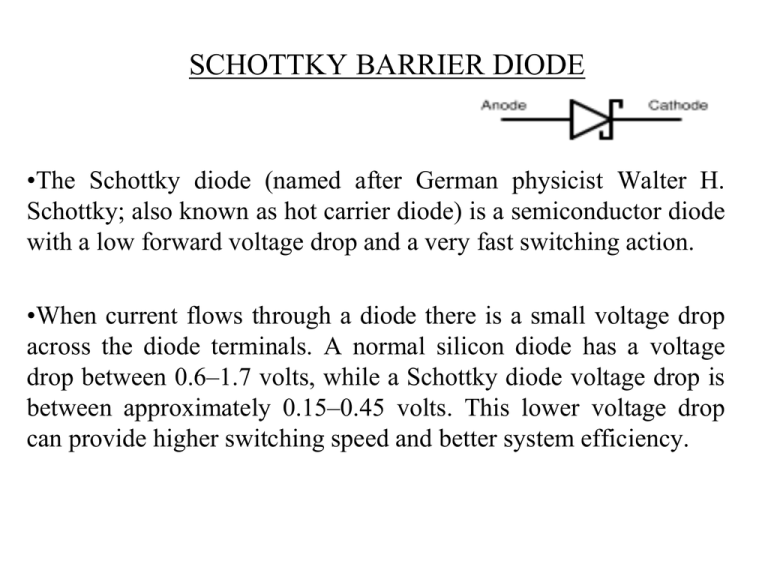
SCHOTTKY BARRIER DIODE •The Schottky diode (named after German physicist Walter H. Schottky; also known as hot carrier diode) is a semiconductor diode with a low forward voltage drop and a very fast switching action. •When current flows through a diode there is a small voltage drop across the diode terminals. A normal silicon diode has a voltage drop between 0.6–1.7 volts, while a Schottky diode voltage drop is between approximately 0.15–0.45 volts. This lower voltage drop can provide higher switching speed and better system efficiency. CONSTRUCTION • A metal–semiconductor junction is formed between a metal and a semiconductor, creating a Schottky barrier (instead of a semiconductor–semiconductor junction as in conventional diodes). • Typical metals used are molybdenum, platinum, chromium or tungsten; and the semiconductor would typically be N-type silicon. • The metal side acts as the anode and N-type semiconductor acts as the cathode of the diode. This Schottky barrier results in both very fast switching and low forward voltage drop. Reverse recovery time • The most important difference between the p-n and Schottky diode is reverse recovery time, when the diode switches from conducting to non-conducting state. Where in a p-n diode the reverse recovery time can be in the order of hundreds of nanoseconds and less than 100 ns for fast diodes, Schottky diodes do not have a recovery time, as there is nothing to recover from (i.e. no charge carrier depletion region at the junction). • The switching time is ~100 ps for the small signal diodes, and up to tens of nanoseconds for special high-capacity power diodes. With p-n junction switching, there is also a reverse recovery current, which in high-power semiconductors brings increased EMI noise. With Schottky diodes switching essentially instantly with only slight capacitive loading, this is much less of a concern. CONSTRUCTION AND APPLICATIONS • It is often said that the Schottky diode is a "majority carrier" semiconductor device. This means that if the semiconductor body is doped n-type, only the n-type carriers (mobile electrons) play a significant role in normal operation of the device. The majority carriers are quickly injected into the conduction band of the metal contact on the other side of the diode to become free moving electrons. Therefore no slow, random recombination of nand p- type carriers is involved, so that this diode can cease conduction faster than an ordinary p-n rectifier diode. This property in turn allows a smaller device area, which also makes for a faster transition. • This is another reason why Schottky diodes are useful in switch-mode power converters; the high speed of the diode means that the circuit can operate at frequencies in the range 200 kHz to 2 MHz, allowing the use of small inductors and capacitors with greater efficiency than would be possible with other diode types. Small-area Schottky diodes are the heart of RF detectors and mixers, which often operate up to 50 GHz. Limitations • The most evident limitations of Schottky diodes are the relatively low reverse voltage ratings for silicon-metal Schottky diodes, typically 50 V and below, and a relatively high reverse leakage current. Some higher-voltage designs are available; 200V is considered a high reverse voltage. • Reverse leakage current, because it increases with temperature, leads to a thermal instability issue. This often limits the useful reverse voltage to well below the actual rating. • While higher reverse voltages are achievable, they would be accompanied by higher forward voltage drops, comparable to other types; such a Schottky diode would have no advantage Applications • Voltage clamping • Reverse current and discharge protection • Power supply 7 *Other Two-Terminal Devices *Schottky Barrier Diodes Two-Terminal Devices Having A Single p-n Junction Schottky Tunnel Varactor Photodiode Solar Cell Other Two-Terminal Devices Of A Different Construction Photoconductive Cell LCD (Liquid-Crystal Display) Thermistor Schottky-Barrier Diode *Surface-Barrier/Hot-Carrier Diode Schottky-Barrier Diode Areas of Application Very high frequency range Lower noise figure Low-voltage or high-current power supplies AC-to-DC converters Radar systems Schottky TTL logic Fig. 20.1 Passivated hot-carrier diode Gold leaf metal contact Anode (+) Metal Silicon dioxide screen Metal semiconductor junction Metal contact Cathode (-) Fig. 20.2 Comparison of characteristics of hot-carrier and p-n junction diodes ID Hot carrier diode p-n junction diode VD p-n junction diode Hot carrier diode Fig. 20.3 Schottky (hot-carrier) diode: (a) equivalent circuit; (b) symbol (a) Fig. 20.4 Approximate equivalent circuit for the Schottky diode Fig. 20.5 Motorola Schottky barrier devices. (Courtesy Motorola Semiconductor Products, Incorporated IO Average rectified forward current (amperes) VRRM (Volts) Case Anode Cathode 59-04 Plastic MBR4040 800 430-2 (DO-21) Metal MBR4030 IN5833 MBR2530 IN5830 MBR1530 IN5827 IN5824 IN5821 MBR4035 MBR2535 MBR1535 MBR335M MBR335P MBR135P MBR4020PF MBR4030PF MBR4035PF IN5834 800 MBR4020 MBR2534 800 IN5832 IN5831 800 MBR2520 MBR1540 500 IN5829 IN5828 500 MBR1520 IN5825 500 IN5826 MBR340M 500 IN5823 MBR340P 200 MBR330M IN5822 MBR320M MBR140P 250 MBR330P MBR130P IN5819 Max VF @ IFM = IO MBR320P MBR120P IN5818 50 IN5820 IN5817 TJ Max 257 (DO-5) Metal 100 40 TC @ Rated IO (ºC) 257 (DO-4) Metal 60 Metal 5.0 35 IFSM (Amps) 267 Plastic MBR030 30 MBR020 20 51-02 (DO-7) Glass 800 85 80 85 80 75 70 50 125ºC Fig 20.6 Characteristics curves for Hewlett-Packard 50822300 series of general-purpose Schottky barrier diodes. 100 Forward current (mA) 10 IF 1 .1 0.1 0 Temperature Coeffiecient 10A -2.3mV/ºC 100A -1.8mV/ºC 1.0mA -1.3mV/ºC 10mA -0.7mV/ºC 100mA -0.2mV/ºC T = 100ºC T = 25ºC 100 200 300 400 Forward voltage (mV) 500 600 700 T = -50ºC I-V Curve Showing Typical Temperature Variation for 5082-2300 Series Schottky Diodes (a) 100 500 Reverse current (nA) 2900 2303 100 50 2301 2302 2305 100 5 10 Reverse voltage (V) 5082-2300 Series Typical Reverse Current vs. Reverse Voltage at TA = 25ºC (b) 15 1.2 1.0 Capacitance (pF) 0.8 0.6 2900 2303 0.3 2301 2302 2305 0.2 0 4 8 12 16 20 VR-Reverse voltage (V) 5082-2300 Series Typical Capacitance vs. Reverse Voltage at TA = 25ºC (c) Schottky diode I-V characteristics Schottky diode is a metal-semiconductor (MS) diode Historically, Schottky diodes are the oldest diodes MS diode electrostatics and the general shape of the MS diode IV characteristics are similar to p+n diodes, but the details of current flow are different. Dominant currents in a p+n diode – arise from recombination in the depletion layer under small forward bias. – arise from hole injection from p+ side under larger forward bias. Dominant currents in a MS Schottky diodes – Electron injection from the semiconductor to the metal. Current components in a p+n and MS Schottky diodes p+ M n n-Si dominant negligible B IR-G Ir-g negligible dominant I-V characteristics qV A I I s e kT 1 where * Is AA T 2 e B kT where B is Schottky barrier height, VA is applied voltage, A is area, and A* is Richardson’s constant. The reverse leakage current for a Schottky diode is generally much larger than that for a p+n diode. Since MS Schottky diode is a majority carrier devices, the frequency response of the device is much higher than that of equivalent p+ n diode.

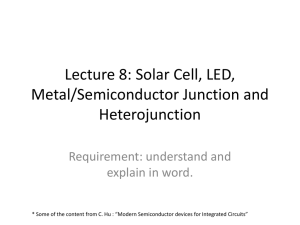
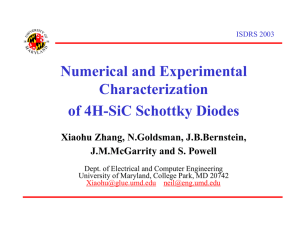
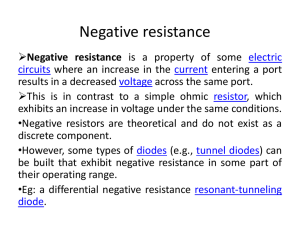
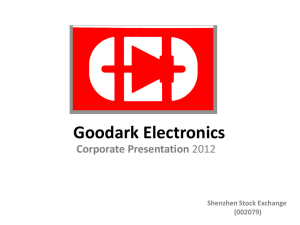

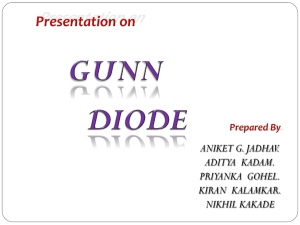
![Semiconductor Theory and LEDs []](http://s2.studylib.net/store/data/005344282_1-002e940341a06a118163153cc1e4e06f-300x300.png)